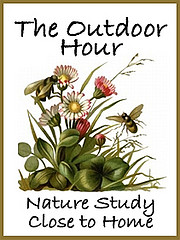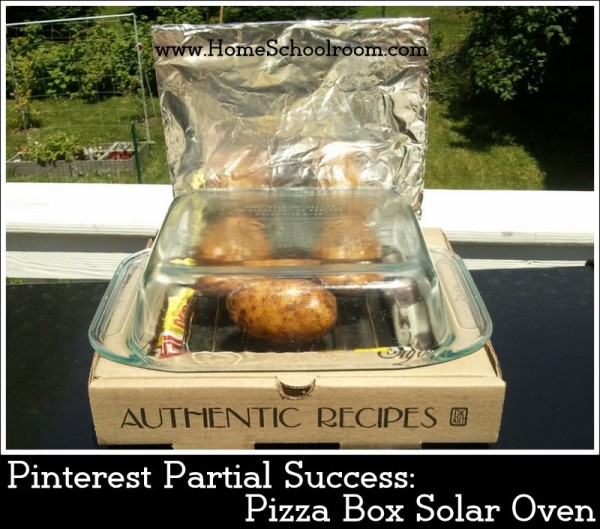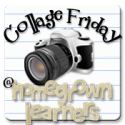 Hi, I'm Heidi and I homeschool my two sweet kids. I want them to know that learning is an exciting lifelong adventure! We love great books, unit studies, notebooking, lapbooking, and hands-on learning.
Hi, I'm Heidi and I homeschool my two sweet kids. I want them to know that learning is an exciting lifelong adventure! We love great books, unit studies, notebooking, lapbooking, and hands-on learning.How I Teach Science Using an Eclectic Lifestyle of Learning
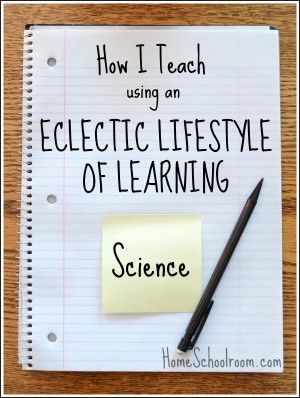
When I decided to homeschool I was excited to share my love of science with my kids. Like other subjects, I tackle it in lots of ways. We used a formal curriculum in the past, but it felt restrictive. That’s not to say I won’t use a formal curriculum again, especially in the later years, but this year we’re on our own.
My overall theory of science education is based in part on Ruth Beechick’s writings. I try to remove myself from the role of “answer giver,” which tends to stifle their curiosity. How do I make sure my kids are learning about the world of science? Easy: it’s all around us and they’re always asking questions!
Let me share specifics about nature study, since that’s a large component of our science studies, and then how we work in other fields of science quite naturally.
Nature Study
Nature study is a terrific area for homeschool science exploration because the specimens you need are right outside your door! It’s a classic part of a Charlotte Mason education and can start your children on a lifelong love of spending time in and observing nature.
Our nature studies are a combination of being open to opportunities and intentional about introducing topics.
Sometimes nature study finds you. This requires providing time in nature and showing my kids I’m willing to put my plans on hold to pursue what they find interesting. In other words, I have to be ready to stop and smell the roses…then look up why flowers have a scent!
When nature topics don’t naturally find us, being intentional about introducing topics can increase my children’s interest in nature. Regularly incorporating nature study is easier with help from Barb at The Handbook of Nature Study blog. She provides ideas, printables, helpful links, and a sense of community in studying nature. Follow her blog and before long you’ll have a nature table and be heading out looking for lichen or drawing dandelions.
Our study of birds is a good example of how studying nature can fosters more interest. We began learning the names of our backyard birds, then did a bird unit study. Now each February we participate in the Great Backyard Bird Count, we continue to learn about new birds we see, find topics we want to research further (like murmuration), and my kids consider themselves birdwatchers.
Nature study is a valued and diverse part of our science education. Here are some other things we’ve done this year:
- Studies the moon and its phases
- Took a trip with Diver Ed for an up-close look at ocean life
- Learned about Squirrels (inspired by our frequent backyard visitor)
- Visited a bird sanctuary for a presentation on owls, then of course we dissected owl pellets (best science project ever!)
- Right now we’re studying weather predicting using the book The Kids’ Book of Weather Forecasting (One of my educational Christmas gifts to my children.)
Other Science Learning
Other than nature study what do we do? Again, I focus on being open and intentional!
Lots of science topics come up naturally. Just think about these questions from my children: Why does my skin form a scab? Why do racing bikes have thin tires? Why does the salt keep ice off the roads? There you have biology, physics, and chemistry! I try to find answers to their natural questions.
A note to other moms like me who plan TOO much: it also doesn’t require a full blown unit study when your child asks how a compass works. Grab a book, watch some YouTube videos and make a start!
Other than pursuing interest-led topics, I work to be intentional about introducing scientific information and skills. My goal is to expose them to the fascinating science all around them and show them how to learn more! Books, videos, and hands-on learning round out our science education.
Science Books
We books we own or borrow from the library for reading aloud, as a reference, or just to leave sitting around to encourage looking through. The books can be filled with pictures, in-depth information, and sometimes even hands-on learning ideas. Right now I’m considering adding The Story of Science (here is a review by a fellow Curriculum Choice author) so we can read about science discoveries that coordinate with our history studies.
Science Videos
We often watch science videos during our “Learning Lunch,” or with my husband on the weekends. Here are some of our favorites:
- Beakman: This is a humorous general science show available on Netflix right now. There are even ideas for projects: my kids still remember the camera obscura we built from a cardboard box!
- Bill Nye: My kids don’t like him quite as much as Beakman, but it is a good show where each episode centers around a theme.
- Science Friday: In these short videos on YouTube they speak to experts in a particular field of science, so it’s neat to see the variety.
- Magic School Bus: These are wonderful for younger kids, sadly we’re beginning to outgrow them!
- How It’s Made from the Science Channel is also on Netflix. It’s fun to see what’s behind everyday items from guitars to cars.
- Mythbusters: There can be adult topics so I make sure to watch with my children, but I find it loaded with good information and a demonstration of the scientific technique. My son will often experiment on his own after watching the show.
Science Equipment and Supplies
I aim to hone their ability to collect, observe and experiment by having scientific tools and supplies in our home. They provide a lot of opportunities for hands-on learning. We add to our materials over time, keep our eye out for used items, and use them as gift ideas!
These are favorites in our home that get regular use:
- Magnifiers and microscopes: from a jeweler’s loupe and pocket microscope (both around $5) to a full size microscope and stereo microscope (purchased used) we enjoy getting an up close look at little things, like snowflakes.
- Snap Circuits: a super hands-on electrical circuit learning toy.
- Models and specimens: a mini skeleton (“Mr. Bones”) and human body with organs (“Mr. Gooey”), insects in acrylic, and our own collection of natural items
- Science kits: These help with specific interests. We’ve enjoyed dissecting owl pellets and testing for bacteria this year. We’re looking forward to working through some new kits my son received for Christmas.
So that’s the not-so-succinct summary of our science learning. Join me next time for how I teach history!
The “How I Teach” Series:
Squirrel Nature Study
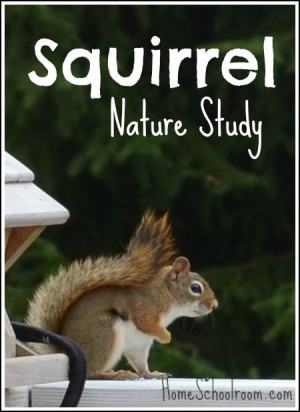
We have fallen in love with a squirrel who frequents the bird feeder on our deck. It’s rare to see squirrels or chipmunks in our neighborhood. Perhaps it is because we lack really old trees…or maybe it’s our abundance of outdoor cats. So our one backyard squirrel has become like a treasured pet.
Learning About Squirrels
One of the Outdoor Hour Challenges this month from Barb at the Handbook of Nature Study blog was a squirrel study, so it was a perfect time to do a more formal study of our favorite squirrel.
- We watched two videos Barb linked to on an older squirrel post. The first showed a squirrel’s acrobatic abilities, and is why my kids are requesting I install some sort of tightrope so our squirrel can cross safely from the trees to the deck out of the reach of cats.
- In addition to information and links from Barb, we learned about squirrels from the Handbook of Nature Study by Anna Botsford Comstock (a must-have nature study reference book).
- We checked out an older book from the library called The World of Squirrels.
- If your children are fans of the PBS show WildKrats check out the gray squirrel episode available on Netflix. My son loves the WildKrats and learns a lot from their show.
Studying Our Backyard Squirrel
Let me introduce you to Nutty. (Creative name, I know.) He’s a North American Red Squirrel. He’s smaller than a gray squirrel and very cute–don’t you agree?
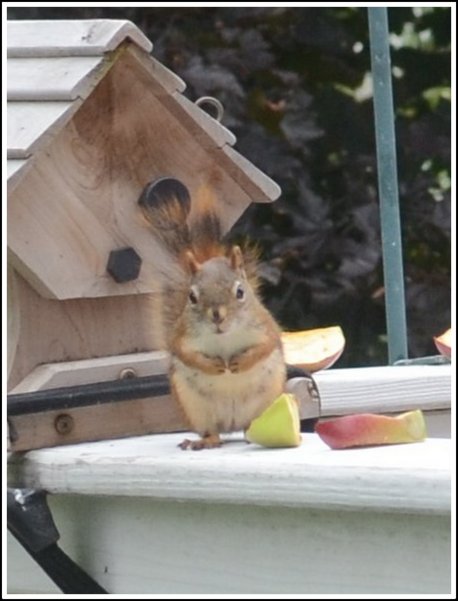
He spends lots of time tucked under the roof of our bird feeder eating sunflower seeds. He’s also tried peanuts and apples, though I would say the sunflower seeds are still tops for him. We read about squirrels eating the seeds from cones, leaving a pile of scales and remembered seeing little piles of scales and stripped pine cones on hikes this summer.
This week my son picked up a couple dozen acorns from a large oak tree on our walk and placed them all over the deck. Once Nutty discovered them he spent time busily grabbing acorns and burying them around our yard and garden.
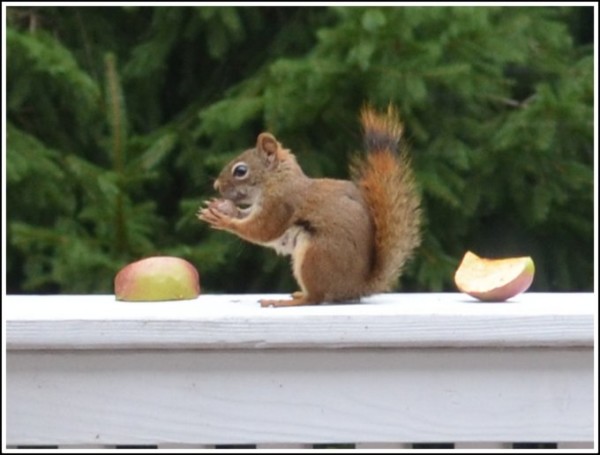
It was entertaining viewing: he’d grab one in his hands, place it in his teeth (squirrels don’t have cheek pouches like chipmunks), dash to what seemed like a predetermined spot (no searching around, just run right to it), dig furiously with his front legs, bury the acorn, then run back to a large spruce tree in our backyard that we think is his home.
Then he’d repeat the process: always running from the spruce tree across the swing set top, down the leg of the swing set, across the lawn to the maple tree, then across the lawn up onto the deck.
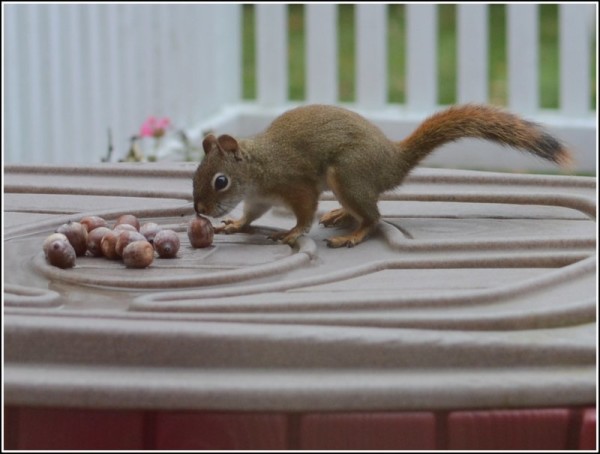
We learned that squirrels do not hibernate, but must eat regularly in winter. We look forward to seeing our little friend and making sure he has enough to eat through this winter that forecasters are predicting will be extra cold…if that holds true for Maine Nutty may need our help! We’re also wondering if Nutty will lose the black stripe on his side in the winter, since we read the black stripe is present only in the summer.
Adding Squirrels to our Nature Notebook
We recorded all that we learned on Barb’s free squirrel notebooking page (link to download is in the OHC post called “2009 set”). Part of the notebook page is recording the tracks. We read about the tracks in the Handbook of Nature Study, and looked online for an image of squirrel tracks. We remembered seeing squirrel tracks in fresh snowfall on a woods walk last winter.
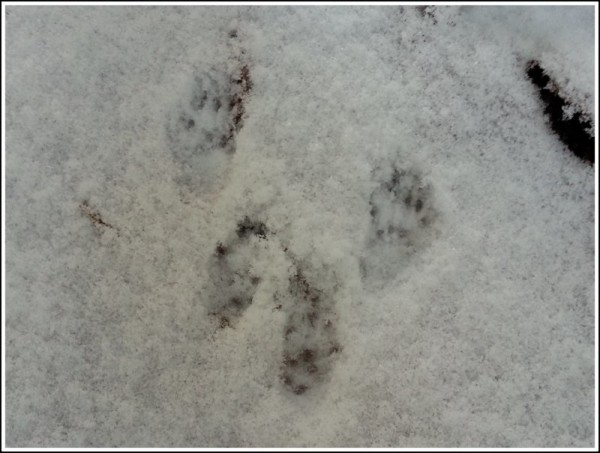
I’ll leave you with a conversation my son and I had this morning about Nutty. My son was wondering aloud if Nutty had a wife. Then he had another thought:
Or maybe he thinks: I’m not going to get married, then she’ll take all my nuts!”
My husband found this extraordinarily funny.
Moon Nature Study
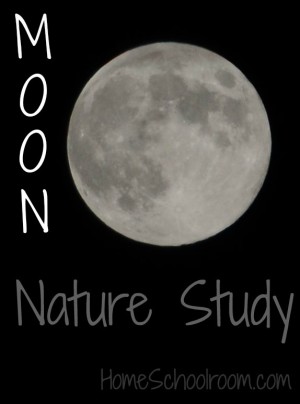
Why does the moon look so different each night?
Following along in nature study with Barb’s Outdoor Hour Challenges at the Handbook of Nature Study blog, we spent a month learning about the phases of the moon.
The first priority was observation: we looked at the moon any clear night from one full moon to the next. One night that involved a fun late evening ride in pajamas for a beautiful view from the local football field.
Note: I took the photo at the beginning of this post. If you want a good moon shot use your manual settings to basically underexpose the photo (my aperture was f/5.6, shutter speed 1/1250). To prevent blurring be sure to use a tripod, or if you’re like me and don’t want to go get your tripod just rest your camera on something stable–I used the post on my front steps. Voila, a moon picture to enjoy!
To record our observations we drew the moon several times for our nature journal as it changed throughout the month.
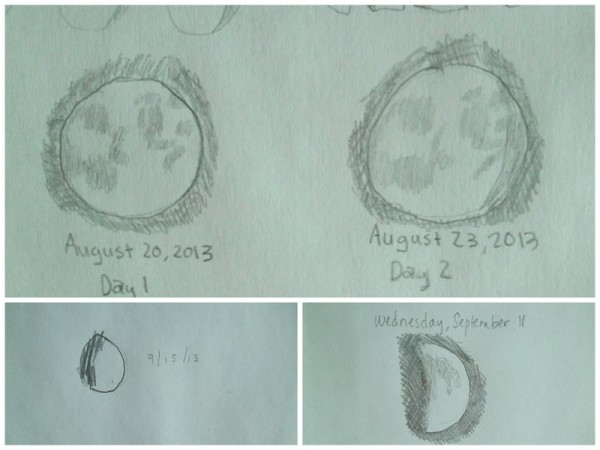
Tip: The kids traced a quarter to start with a nice circle and keep their moons a consistent size.
As with any study we read books from the library. Our favorite was The Moon by Seymour Simon. It has wonderful photos and information, including the stories of the Apollo space program.
Barb shared links to a couple kid-friendly YouTube videos that we enjoyed: one on the distance between the earth and moon in her Moon and Craters Study, and a terrific (and humorous) video on the phases of the moon in her post from a year ago on Moon Names.
To give my kids a better understanding of why we can only see parts of the moon sometimes we headed to the deep, dark basement for a hands-on demonstration of the moon phases. This idea was in the Handbook of Nature Study by Anna Botsford Comstock–a terrific nature study reference book.
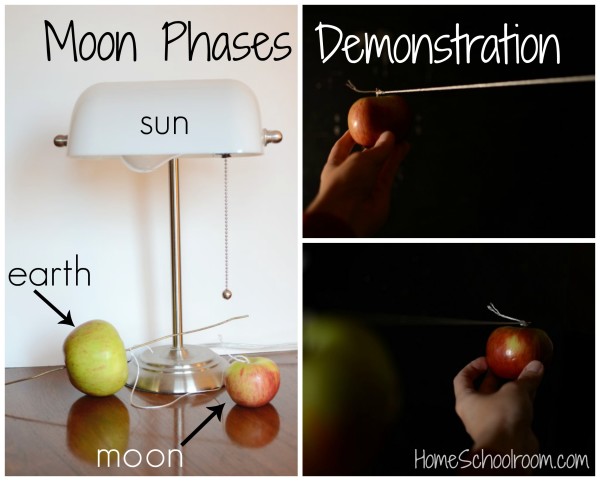
Basically the lamp is your moon, the apple mounted on stiff wire (I cut a piece of wire coat hanger) is your earth, and the small apple tied to the wire is your moon. Position yourselves to look from the vantage point of the earth apple, and you will clearly see the phases in the light falling on the moon apple. I love simple demonstrations!
Trying a Trio of Pinterest Projects
Pinterest is a very helpful tool and has replaced my browser’s bookmarks as a way to save projects for later. The photos make it so much easier to scan through my links. We thought it would be fun to have a little Pinterest Challenge at iHomeschool Network to encourage us to complete some of those pretty pins.
Here are three projects I gave a whirl: one complete success, one that required a little tweaking to be successful, and then one that hasn’t succeeded fully–but I’m not giving up!
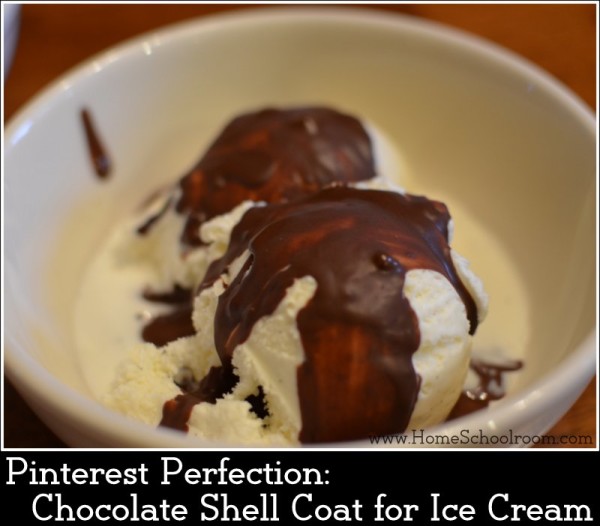
Project #1: An utterly delicious ice cream topping.
Have you ever ordered a chocolate dip cone at an ice cream shop or used homemade shell topping from the grocery store? Well, Family Fun hasan easy recipe for a homemade version that is not only scrumptious, but easy and made with items I keep on hand. Homeschoolers can point out the science, too: how our coconut oil is liquid at high temperatures but solid when cool, so mixing that with chocolate helps give us that thin coat that hardens on contact with ice cream.
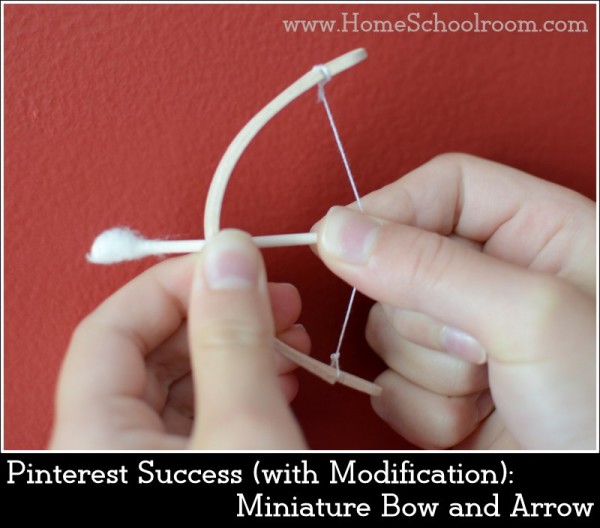
Project #2: Mini Bow and Arrow Craft
My son has been wanting to make this miniature bow and arrow for months, so this challenge prompted us to give it a try. Following the directions exactly our first attempt was fun but needed some tweaks to really work well.
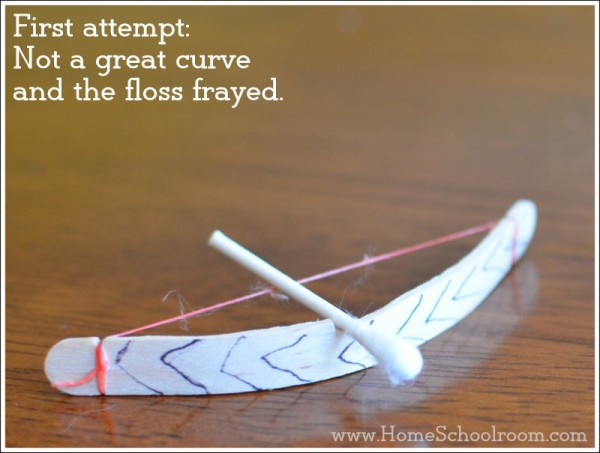
We didn’t get a great bend in our popsicle stick–it was hard to hold the tension on the curve of the wet stick while tying floss. Also the floss was not durable–it stretched over time (losing even more of the bend in our stick) and began fraying with use. Maybe I buy cheap floss? The coating also made their fingers sticky and scented.
I remembered another pin I have for making bracelets from popsicle sticks, so I used the directions there. You soak the sticks, put them inside a glass to form the arch, and allow them to dry there.
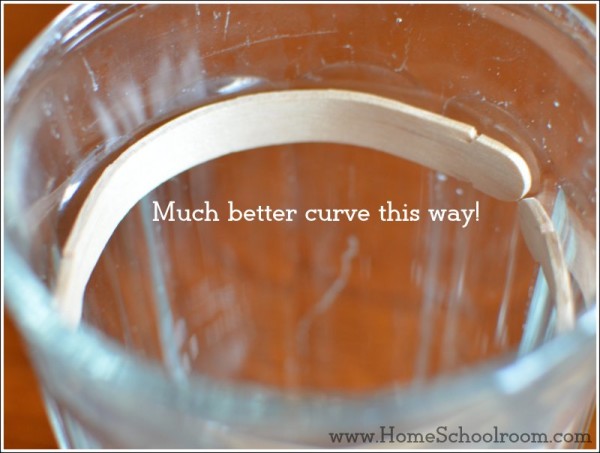
This gave us a beautiful bow that kept its shape (even now, a couple weeks later). My second tweak was to skip the fraying floss and use a stronger string. In our case I used craft thread. This made a more durable bow and led to quite a bit of fun with target practice and experimenting for the kids.
Project #3: Pizza Box Solar Oven
I’ve been wanting to try a solar oven forever! I used instructions from Home Science Tools; they even have a PDF with recipes to try. I followed the instructions as closely as I could. I built up quite a bit of heat (175 degrees was the highest) and my potato was hot, but not fully cooked.
I see a couple reasons for my failure:
- I chose a tricky food for my first try, I think–a baked potato. Unlike hot dogs or s’mores that many solar oven recipes prepare, you need some serious heat over a long period of time to bake a potato. But hey, I’m never one to take the easy way out.
- I had a couple small openings behind the glass pan that allowed heat to escape. Plan: Block any place air can exit!
- I had three potatoes, which created a lot of thermal mass for a small oven to heat. This site has wonderful information about the science and history behind solar ovens. I’ll try with one potato next time.
- I didn’t have enough time–I started around noon and then didn’t check on it the last hour so it ended up being in full shade when I checked at 5 o’clock. I lost valuable cooking time! Next time I’ll start earlier and remember to check frequently.
Like I said, I’m not giving up yet! In fact, I love that this didn’t work the first try. It gives me a chance to model for my kids “If at first you don’t succeed, try, try again.” They were very skeptical so now I’m determined to show them that we can bake a potato using power from the sun!
If you’re looking for more ideas for your homeschool or fun with your kids, visit my Pinterest boards. Do you like using Pinterest to organize ideas? And do you often get a chance to go back and actually do those wonderful activities?
Pop over to iHomeschool Network to visit other bloggers who tried out some of the projects sitting on their Pinterest boards.
Successful Start to Summer Schooling
Summer school is fully underway, hooray! I’ve made my notes to just leave June alone next year, and plan on a July start of more structured learning. That way I don’t feel “late” or “behind.”
We’ve been using the weekly checklists I made for the kids since early June and earlier this month started working away at our summer curriculum plans. I purposefully didn’t plan a lot of formal schoolwork, but tried leaving us open for relaxed learning. As a die-hard planner I wondered if this would work or if learning wouldn’t happen if I didn’t have it all written in my lists. The good news is we’ve learned a lot without me planning and directing everything! (Shocker, I know.)
Nature Study
Two new-to-us insects from nature found us this week:
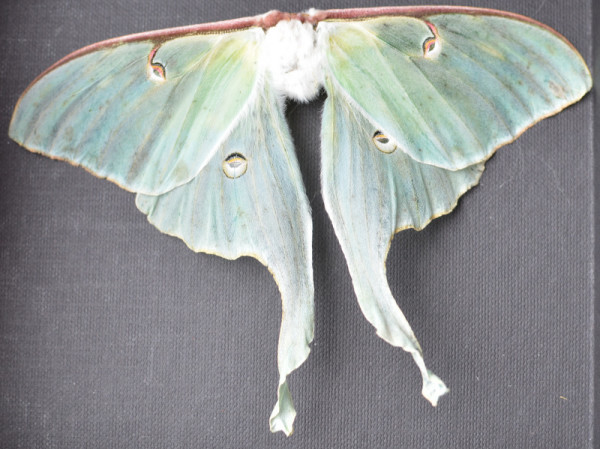
My father-in-law brought this magnificent luna moth specimen to us. He shared a lot of information with us, and I later found this YouTube video of the luna moth life cycle that has wonderful footage of the moth and equally wonderful explanations of all the things that make it so interesting! We realized how lucky we were to see one, since they are nocturnal and adults only live one week. By the way, the adult luna moth doesn’t eat–at all. It comes out of the cocoon just to reproduce and die.
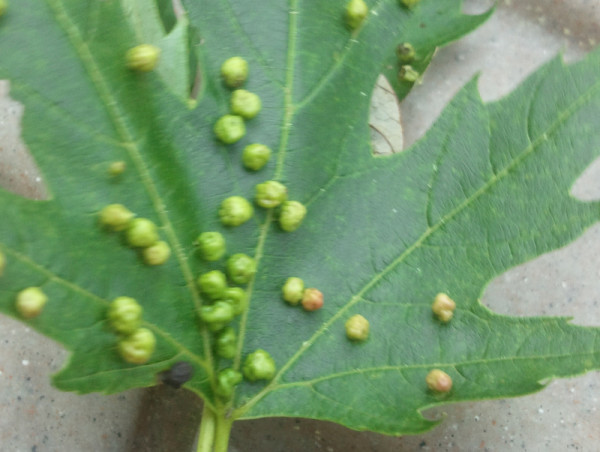
Another day I was mowing and noticed these wart-like growths on some maple leaves. I envisioned a crawly little insect or worm hatching out, so we put a few leaves in the bug catcher for observation…nothing happened. After a Google search I discovered they were galls formed by a mite that overwinters in the bark of the tree. The leaf produces the little pouch-like galls that surround the mite, which continues to live, feed, and breed within the gall. Luckily it isn’t likely to damage the trees. Insects are fascinating!
Science
We attended a Mad Science presentation sponsored by our library called “Dig Into Science: Journey to the Center of the Earth.” It was an interactive, action-packed hour where we all learned a little something.
Reading Aloud
We have been completely entranced by the Chronicles of Narnia. I’m reading the books aloud (starting with The Magician’s Nephew) and after we finish each one we’re listening to the radio dramatization from Focus on the Family (which is superb, by the way). I really wanted to read the series, but was a bit worried after all of us disliked The Hobbit. I wondered if we were fantasy-challenged but we all love this story.
Educational Television Viewing
My daughter has always enjoyed the “Dear America” books, and we stumbled across Dear America videos on Netflix. There are 12 half-hour episodes: nine are historical fiction stories from American history, three are the “Royal Diaries” versions that tell of a famous princess. I highly recommend them! They’re perfect for relaxed summer learning and have led to great discussions and role-playing the characters and time periods in their free time.
And a side note: I’ve talked about learning to loosen up on my themes and let go of my constant attempts to keep topics neatly grouped together. The old me would have written down this great resource and tried to use each video at its appropriate time in our history studies. The I’m-still-learning-to-let-go me not only let my children go ahead and watch Cleopatra (even though we’ll be studying her next school year) but I didn’t even require they watch the videos in order chronologically. How’s that for progress?
We are enjoying our new favorite science show, Mythbusters (many episodes also available on Netflix). My son loves the show and it really inspires him to experiment. For instance, on one show they were testing vehicles in tornado-force winds. The rest of the afternoon my son built Lego vehicles and tested them in wind. We played around with fans and a blow dryer to get the strongest wind. (And when I heard the leaf blower of the lawn company working down the street the crazy homeschool mom in me was tempted to ask to borrow it.)
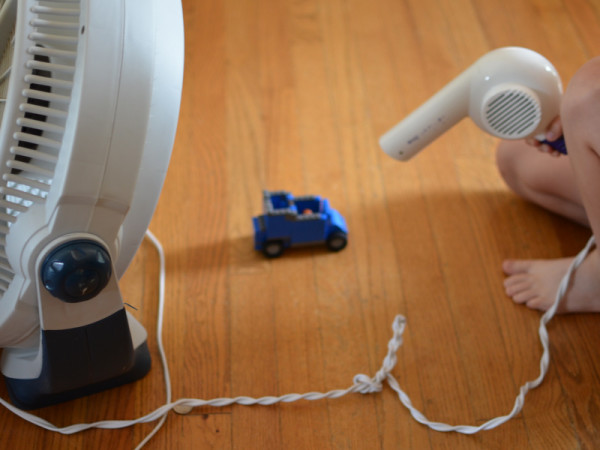
My favorite part of the show is how they model that everything doesn’t always work perfectly on your first try–often something fails and you have to try and try again!
Art
I shared our wire sculpting based on the book Norman the Doorman. Trying out a completely new art medium was great fun for all of us.
I have another homeschool experiment–if less planning can still mean a lot of learning, will this work in the area of art, too? Our art supplies are conveniently located in a big hutch near our kitchen, but neither of my children tends to get them out unless I’m directing a specific art project. I tried a little experiment one hot afternoon and got out the watercolor paints, telling them to paint whatever they wanted.
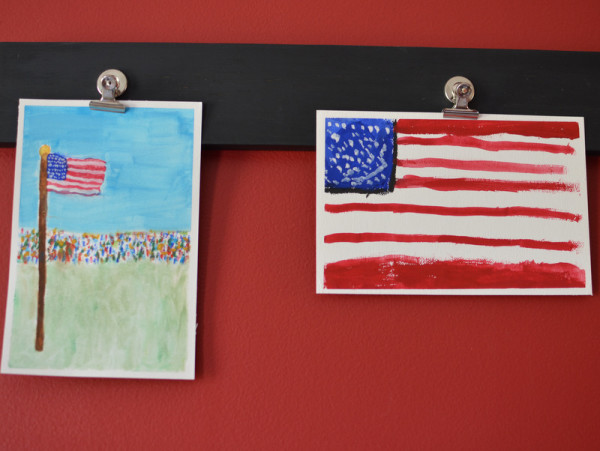
It worked wonderfully! This isn’t to say that I don’t want to do art projects with instructions for learning skills, but I think I’ve overlooked the importance of also giving them time to just create on their own.
And All The Other Things That Summer Brings!
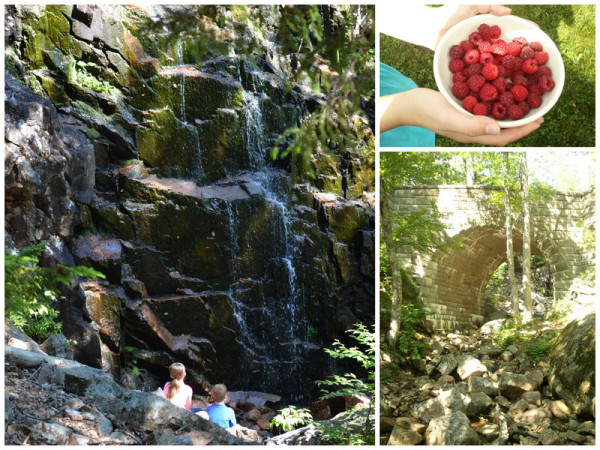
We hiked to a waterfall in Acadia National Park, walking on the historic carriage roads part of the way. Our summer goal is 10 new adventures, meaning a hike or visit to a lighthouse we’ve not seen before. This is number three checked off! I feel good about that progress. And speaking of progress, we’re beginning to see some produce from our gardens. Not enough to make jam or anything, but some raspberries made a delicious snack!
Have you been working on summer goals, either educational or just for fun?
Thank you to the wonderful hostesses with wrap-up link-ups. Be sure to join the fun and see what other homeschoolers are up to!
Celebrating Accomplishments and Planning Ahead
Our goal each year is to complete our standardized tests during the week before Memorial Day, so after Memorial Day we can slip into our relaxed summer school schedule and feel like the last school year is behind us and we’re working ahead on the next year (not finishing the last). We focus on learning together in the summer so the kids worked extra hard to finish their individual subjects: the biggest goals for each were Teaching Textbooks 5 for my daughter and Funnix reading instruction for my son. I was proud of their focus so when my son said we should have a party I said, “Of course!”
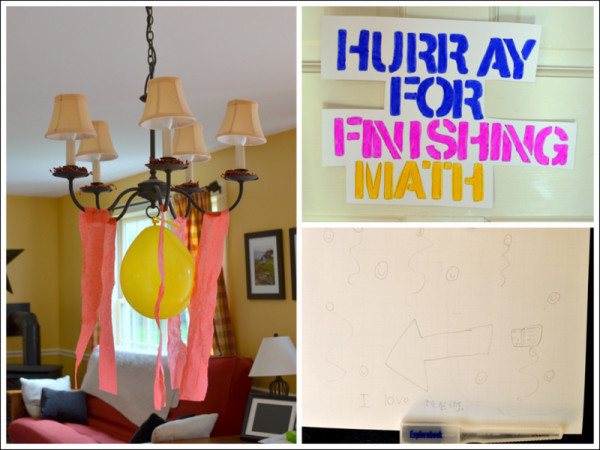
That evening we held an impromptu party to celebrate. I blew up the one lone balloon I could find, my daughter used strips of tissue paper to make things festive, and they both made posters. I don’t know if you can see clearly in the photo, but my son’s says “I love reading.” Does anything else warm a homeschool mom’s heart more than that? For dessert I whipped up brownies-a-la-mode.
I realized a side benefit to agreeing to the party–they excitedly cleaned up the house so it would look nice for the party. I think I see frequent “parties” in my future!
Other Homeschool Happenings This Week
We’ve been working on a Civil War Unit Study that I am trying to wrap up before testing week. I’m trying to make the type-A list maker in me relax if we don’t and allow it to flow over into summer. There is just too much to learn and discuss!
We were visited by two new-to-us birds this week. We adore our backyard birds, who are really more like friends. I’ll need to make new field guide cards like I posted about in our backyard birds nature study post. I can’t tell you the excitement when we meet a new “friend.” Everything stops and we grab field guides, cameras and binoculars.
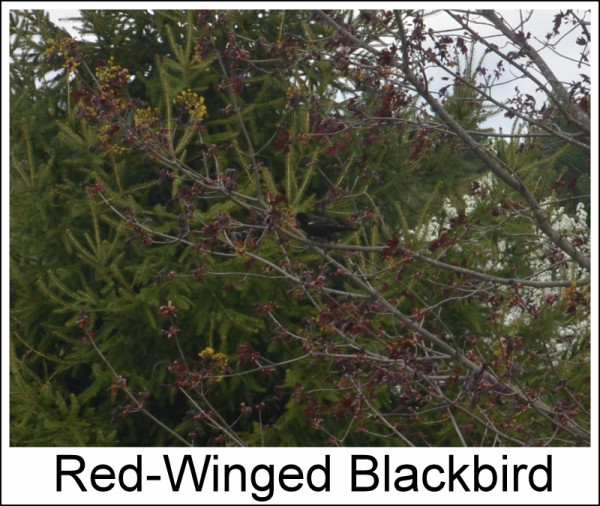
First was a red-winged blackbird. We’ve already learned his call because he keeps sitting on the tree right behind our deck and singing away! I read that the males return from migration first and sing to defend their territory, so perhaps that was his goal.
I am curious if we continue to see him because according to my book they nest near shallow water and other than a couple small wet areas in our neighborhood we aren’t really near water. My boy liked the fact that this bird likes to show off his bright wing bars (called epaulets) because it reminded him of generals.
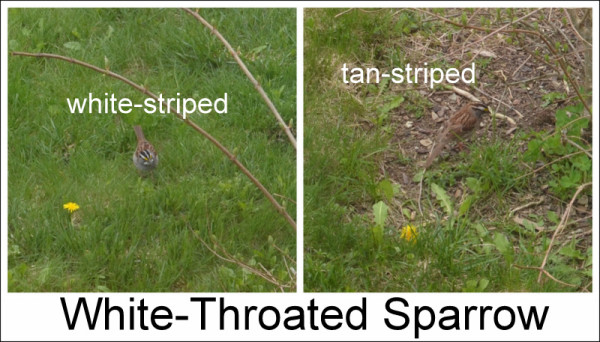
Our next friend was the white-throated sparrow. I was fascinated by the two different color variations, white-striped and tan-striped, which I initially thought were two different species. The field guide says white-striped adults tend to mate with tan-striped adults but scientists don’t know why. Isn’t that fascinating? I love showing my kids how there are still things to be discovered and understood in the world!
Things I’m Working On
Planning! I love it but wish it was all I could do for a few weeks. Once I start dreaming and scheming about next year it’s hard to focus on anything else. I’m narrowing down the major subjects, have papers scattered about me at all times with notes, ideas and figures.
One of my biggest struggles with planning is to plan a reasonable amount. I am never short on ideas and I am intrigued by nearly all subjects, so I tend to over-plan and then feel “behind” when we can’t get it all done. That isn’t just in homeschool but tends to happen in my life in general.
My goal is to simplify so we’re focused on the subjects and learning methods that leave us entirely enriched but also happy and relaxed. Can I plan more reasonably now, with two years of experience? Do any of you struggle with over-planning?
Thank you to the wonderful hostesses with fun link-ups on Fridays. Be sure to join the fun and see what other homeschoolers are up to!
Spring Nature Study and Easter Celebration
When I finally grabbed the photos off my camera I realized how much we’d done the last two weeks! Easter celebrations and a whole lot of nature study filled our time.
Moss Nature Study
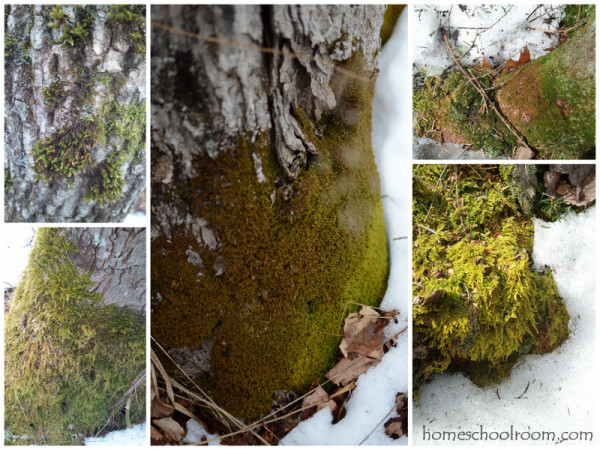
We were on the lookout for moss during several walks in the woods. One day it was finally warm enough that everything wasn’t frozen solid so I could break off some pieces of rotting trees for moss samples. I had been anxious to bring some home to put on the nature table like Barb did in her Moss Up Close post.
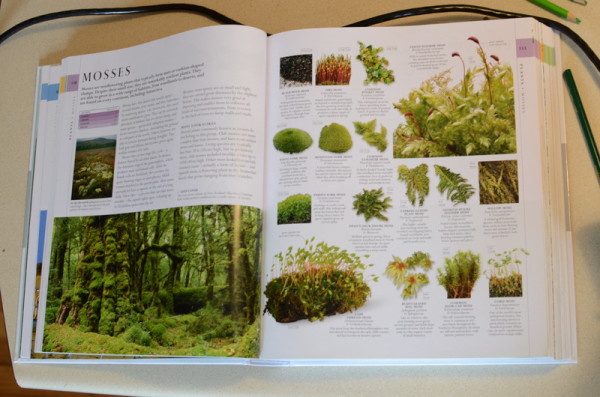
We read about moss in our Smithsonian Natural History book and then watched the animated video of moss life cycle from Barb’s 2008 Moss Nature Study post. The terminology and specifics in the video was too advanced for a 7 and 10 year old, but the animation gave them an overall idea of spores and their release from the capsules.
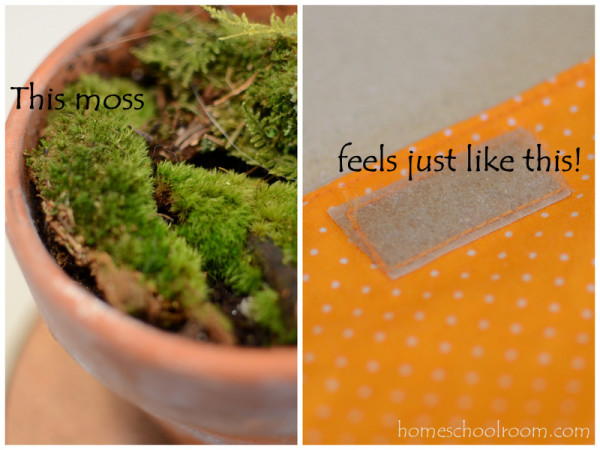
Feeling one of our moss samples reminded me of the feeling of a very familiar material–the soft side of velcro!
We examined our moss with magnifying lenses and a stereo microscope. Happily one of our samples had stalks and capsules! We also are fortunate to have a box of old slides from a high school–one of which was the cross section of a moss capsule. Everyone completed Barb’s free printable moss observation page.
Bracket Fungus Nature Study
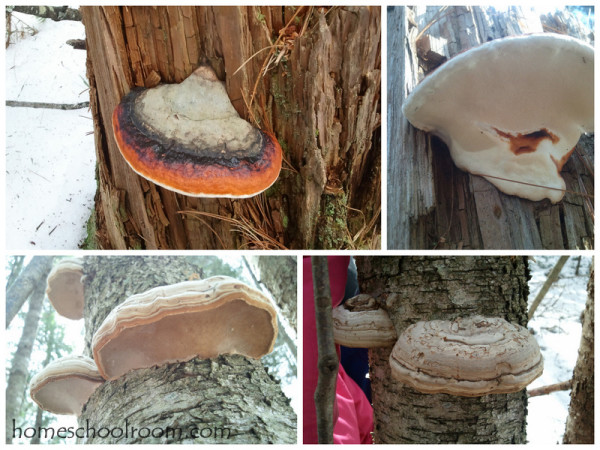
On another beautiful early spring day we headed to the woods on a bracket fungus hunt. After imagining the moss to be fairy forests my daughter decided that the bracket fungi were like fairy stadiums.
I shared with the kids the story from the Handbook of Nature Study of how a little spore enters through a break in the tree and grows deep into the tree, and how the bracket we see is really just like the flower–the real part of the plant is hidden in the poor tree, which is doomed to an early death. We were able to bring a few bracket fungi home to inspect. The magnifying lenses revealed the millions of tiny tubes opening onto the underside.
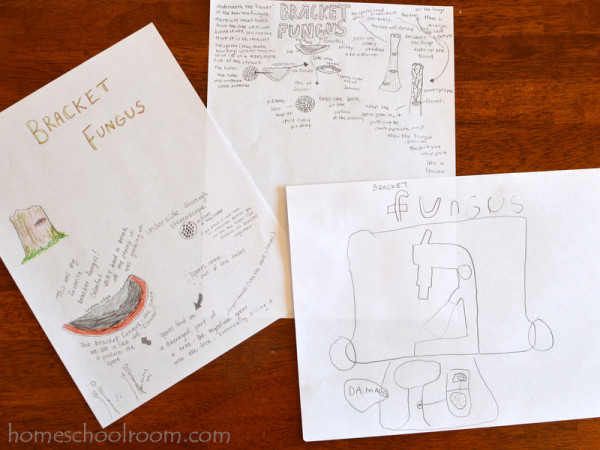
More nature journal pages! My daughter just loves it when I join in on nature journaling. I love seeing the differences in what interests each of us about our nature study subjects.
Mallard Nature Study
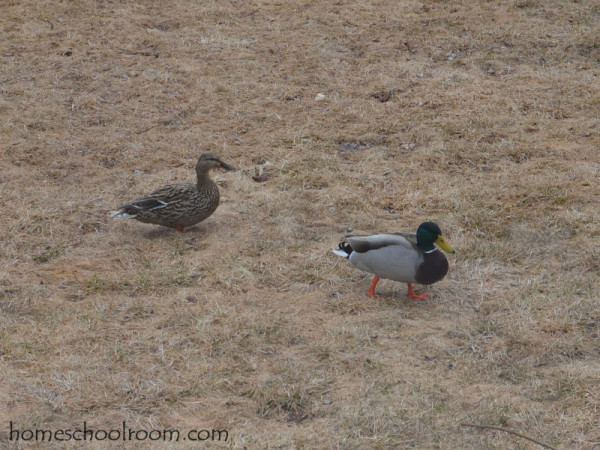
Our third nature study subject found us: Mallard ducks in our backyard! It’s very unusual, for though there is a marshy area in our neighborhood it does not border our property. The only other year we’ve seen a Mallard in our yard was several years ago during a very wet spring. We saw them three different days this week and an impromptu mallard study ensued.
I found bits and pieces of information in books we had. National Geographic Kids had some more details. Though Cornell’s site is my go-to reference for backyard birds it was the last place I checked for Mallard information. Duh. The All About Birds Mallard page was a wonderful resource with videos, audio clips and extensive information. The video of the adult duck “dabbling” for food (they don’t dive, just tip their heads in with hind end in the air) and the mating ritual (their heads bob in unison like a silly dance) had my kids in stitches.
Other happenings of the last two weeks:
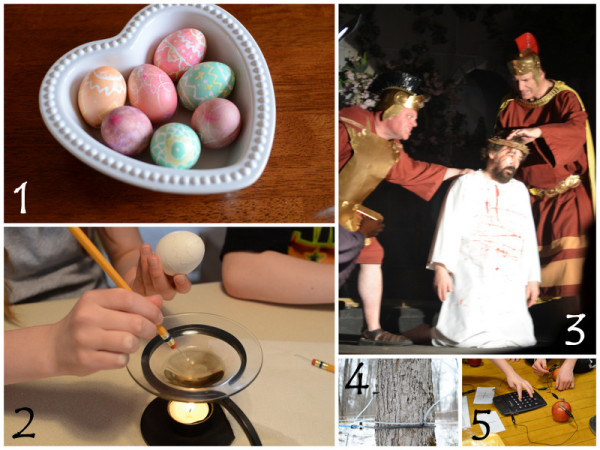
1 & 2: We tried a new egg dying technique this year after reading Rechenka’s Eggs. It was a modified version of Pysanky from our book Everything You Never Learned About Birds. It involved using the head of a pin to apply melted wax, and adding layers of dye and wax. Quite labor intensive, but very fun.
3: A beautiful Messiah play has become a yearly tradition that grounds us all in the midst of bunnies and candy eggs.
4: Another yearly tradition: a visit to a maple syrup producer for Maine Maple Sunday.
5: A science program called Garden Batteries had us powering lights and calculators with produce. This was very fun and I see more experiments in our future.
One last note: I must again express my gratitude for our homeschooling lifestyle. At a library event a few public schooled boys made some completely inappropriate comments to MY little girl. I was able to use the opportunity to have some frank discussions with my daughter. Oh, how glad I am to be present with her and have the relationship with her where she’ll tell me things. How glad I am that her education can take priority in her days, not the sad state of socialization in most schools.
Thank you to the wonderful hostesses with fun link-ups on Fridays. Be sure to join the fun and see what other homeschoolers are up to!
I’m Liking Lichen
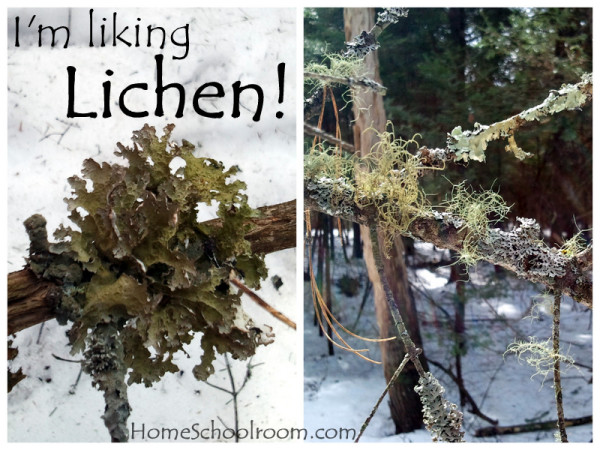
Pretty cheesy pun, I know, but I am suddenly appreciating lichen after years of never giving it a second look. Lichen is so prevalent that it seems ordinary, and I’m guilty of not taking the time to really observe it or point it out to my children. But, as with many things in nature, the more I pay attention the more fascinated I become! Participating in the Outdoor Hour Challenges with Barb from The Handbook of Nature Study blog encourages me to study topics in nature I may overlook.
Luckily even in Maine where the ground is still covered in snow like it is this March we can find lichen. We walked in the woods and were surprised at its diversity. I grabbed a couple branches from the ground with samples to bring home.
Since I had never paid much attention to lichen coming into this study I felt like Barb did in her post about moss and lichen back in 2008, when she said she had to do more research and observation for this study because she was so uneducated about it. The information on lichen in the Handbook of Nature Study book was uncharacteristically slim, but Barb’s newsletter had a very useful page on the three kinds of lichen that I printed and kept on our nature table.
I also found two helpful videos. The first video from Science Friday helped us understand what lichen is–actually three different organisms (fungi, algae and bacteria) coming together to make a composite organism that can survive in almost any environment.
{As an aside, I love their videos. Science Friday is a two hour radio show on NPR, but they also make short videos. All of the ones I’ve watched so far have been wonderful! They are concise, the narrator speaks clearly, and they always talk with an expert in the field–in this particular case a lichenologist. Check out Science Friday’s YouTube channel, I think you’ll love it!}
The second video is from Clemson University’s extension program, and it describes the different varieties of lichen and what lichen needs to grow.
After the videos we inspected our samples with magnifying glasses and a stereo microscope, making drawings for our nature journals.
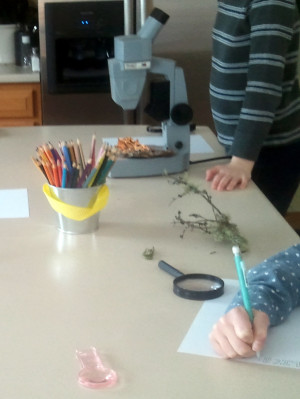
My son’s page cracked me up. He really enjoyed the Science Friday video and the cartoon they used to illustrate the different components of lichen (you can see the characters at the very bottom of his drawing).
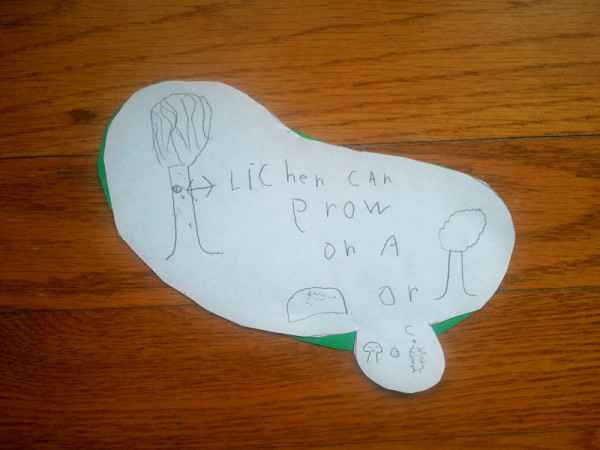
(Notice the question mark over the bacterium because they aren’t sure what it’s purpose is.) He also then took his drawing into another room to secretly cut it out and back it with green paper because “he knew I’d like that.” He knows his crafty mom likes it when he spends time making his work detailed.
We learned quite a bit, and I’m already noticing us paying a lot more attention to lichen when we’re out and about. Touring a sugar bush for Maine Maple Sunday found us also pointing out interesting lichen samples.
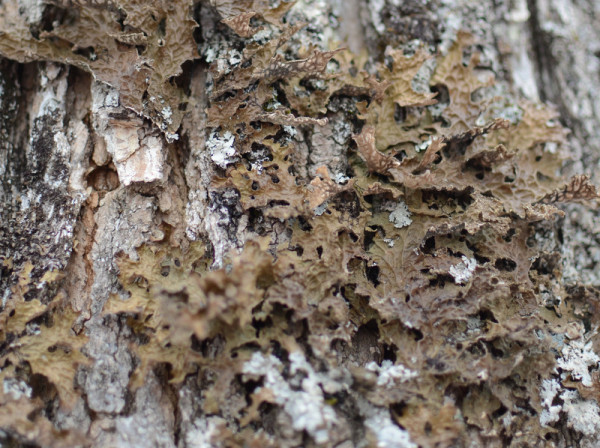
Next I hope to learn a bit about moss, since we can still find samples above the snow. I plan to copy Barb and bring moss in for our nature table, and I like her printable for moss observations.
Any one else working to keep nature study going in a long northern winter?
Nature Study ~ Birds
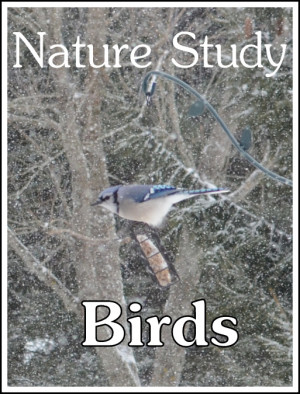
Our nature study has been all about birds for the last 6 weeks. It’s a good winter topic for Maine–they are one of the few living things outside that aren’t covered in snow! We focused on the basic features of all birds and the specific birds that we see outside our window.
Resources For Studying Birds
- Handbook of Nature Study bird posts ~ Barb guides you through nature study, and this is the reference page that links to all her bird-related posts
- Handbook of Nature Study by Anna Botsford Comstock ~ the big black reference book for nature study, I highly recommend having this one on your bookshelf. I use it mostly to educate myself so I can guide our observations in nature, though I sometime read short sections to the kids.
- Birds of Maine Field Guide ~ I highly recommend the state guides by Stan Tekiela. We love this book and it has made it much easier to identify new-to-us birds. The entries are organized by color, so if you see a bird that is primarily brown or blue you can look in that section and find just birds of that color likely to be in your state.
- Burgess Bird Book for Children (available as a free Kindle book) by Thornton W. Burgess ~ I enjoy the Burgess books for children–sweet stories with factual information.
- Everything You Never Learned About Birds by Rebecca Rupp ~ a wonderful book filled with scientific details, hands-on learning activities and amusing tidbits and stories. One of those really fun nonfiction books that works well even as a read aloud.
- All About Birds ~ The amazing online bird guide from the Cornell Lab of Ornithology.
- Nestcams ~ We kept an eye on two nestcams from Ustream: a hummingbird and eagle nest, both with two nestlings. They provided us with a great opportunity to observe things that would be impossible to see first-hand in nature.
The Egg
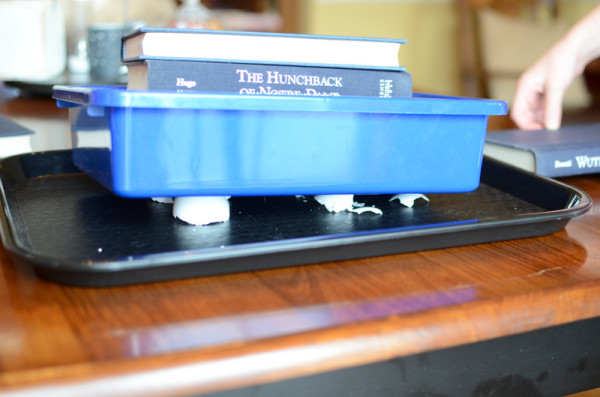
After reading about the egg in Everything You Never Learned About Birds we tried this experiment to see exactly how much weight eggs could hold. I cracked two eggs as close to the middle as I could. (I tapped with the dull edge of a knife to try and break it evenly all the way around.) We placed the empty shells down and tested to see how much weight they could hold.
Even I was amazed when they broke at just over four pounds–roughly the weight of a hen! It seems they were perfectly suited to withstand their mother’s weight. We were able to tie the idea of the strength of the dome shape into our recent visit to our state capitol building.
Bird Bones
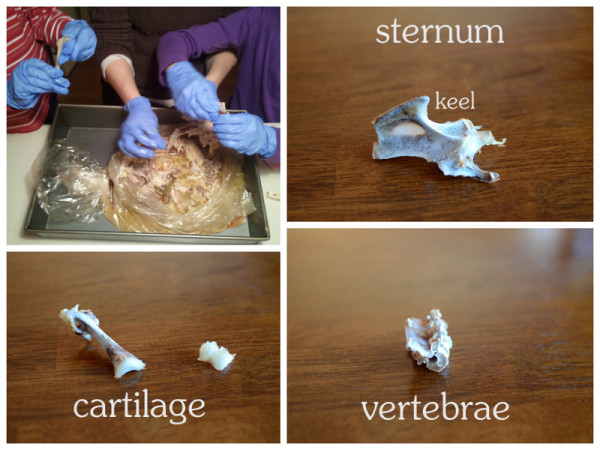
Who but a homeschooling family would have a baked chicken for dinner just so they could examine the skeleton after? I was glad we went through the effort, because even though my daughter was initially horrified at the idea she, too, was interested in all we saw. We were able to spot many things we have in common with birds: vertebrae (and even the spinal cord!) and cartilage. I was hoping to show a cross-section of a bird bone and show how they are lighter and more hollow than mammal bones–but that just wasn’t easy for us to see. The most amazing feature specific to birds was the large “keel” where the chest muscles attach to the sternum. Comparing it to our breastbone (on our skeleton model) the difference was incredible.
Feathers and Flight
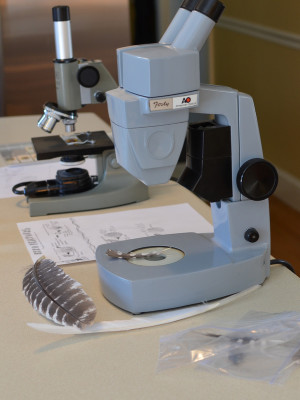
We examined the details of a feather under the microscope. This is the part I love about nature study: the more you learn the more amazed you are with the intricacy of nature! All of us were intrigued examining the microscopic features of a feather, especially the little hooks that keep the parts of a feather together forming a neat fan. (We decided it was kind of like Velcro!)
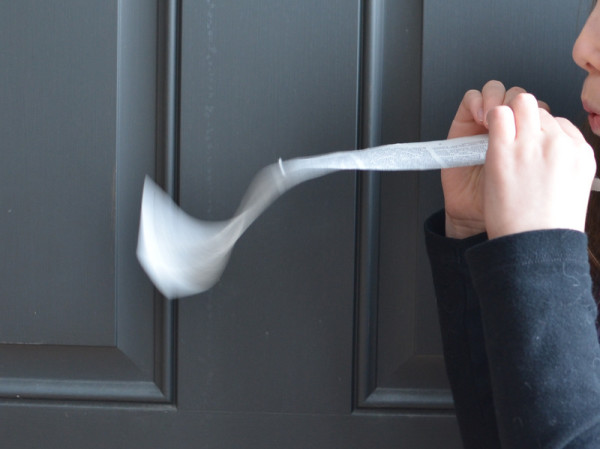
We’ve read about both bird and plane flight before as it has come up in questions from my son. This easy demonstration was one that even I was surprised worked so well and had us all ooh-ing and ahh-ing…and blowing on newspaper until we were dizzy! Simply hold a 3-inch by 12-inch strip of newspaper just under your mouth and blow. It may take a minute to get it just right, but when you do the newspaper will flap upwards. It’s a great hands-on demonstration of lift, more officially known as Bernoulli’s Principle!
Getting to Know Our Backyard Birds
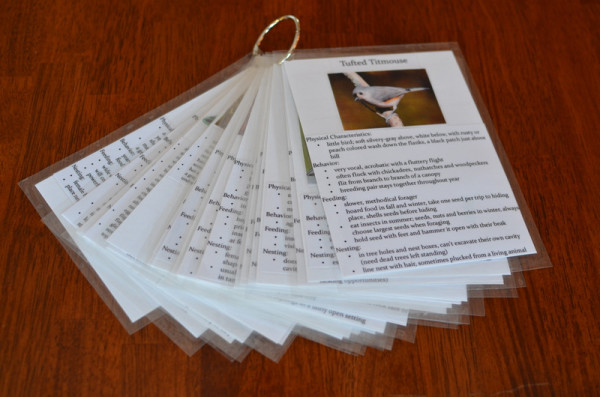
We focused the rest of our time on learning even more about our backyard bird friends. We started our own field guide (Outdoor Hour Challenge #7) last year, and added new birds this year. While I enjoy our growing collection of field guides, I love having our own guide to just our backyard birds. On each card I put a picture and pertinent information, and also add interesting tidbits on the back.
We spent extra time on a few of our frequent backyard birds.
- Barb has a great post about the crow with a video. We can get frustrated with the crows who take all our suet and scare away smaller birds, but after Barb’s post and the accompanying pages in the Handbook of Nature Study (p. 124-127) we had to appreciate their intelligence.
- We have Chickadees, Nuthatches and Downy and Hairy Woodpeckers in our yard. Using information from the Handbook of Nature Study I shared with my children about how these birds comb over different parts of the tree looking for insects and their eggs. The interplay of these species again prompts us to marvel at creation.
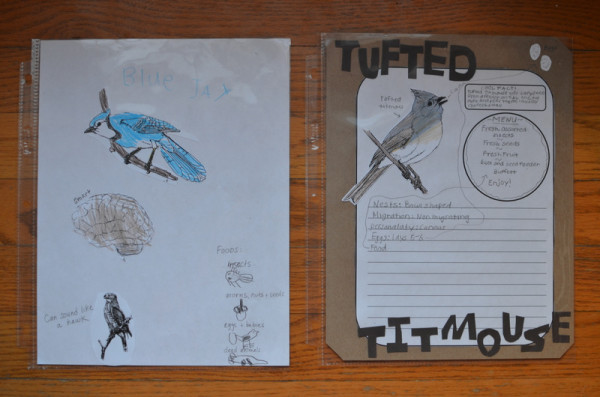
- I had my children choose their favorite bird and create a notebook page. We used the coloring images from the free Cornell bird coloring book, and then I set them free to record the facts they found interesting.
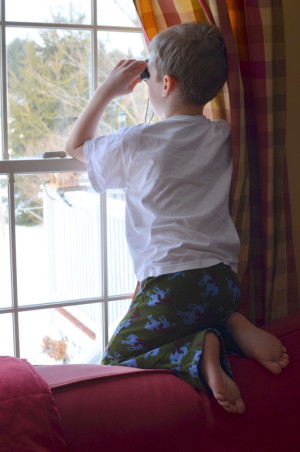
- The highlight of our bird study was our second year participating in the Great Backyard Bird Count. Read over Barb’s post about the GBBC and you’ll be persuaded to become a citizen scientist, too! Here are our 2013 bird counts, with the highest number seen of each species at one time:
- White Breasted Nuthatch: 2
- Red Breasted Nuthatch: 2
- Black-Capped Chickadee: 6
- Dark-Eyed Junco: 3
- Crow: 3
- Blue Jay: 3
- American Goldfinch: 14
- European Starling: 2
- House Finch: 1
- American Tree Sparrow: 2
- Common Redpoll: 1
- Cardinal: 2
- Mourning Dove: 1
I love that even in a small in-town yard we can enjoy these marvels of nature right outside our window. And as with all nature topics, I often feel like we’re just scratching the surface of what we want to learn! Our next goal is to learn the songs of our backyard birds.
I’ll end with this video that blew our minds of starling murmuration. Unbelievable!
I’m participating in Barb’s Outdoor Hour Challenge carnival, head over to her blog for encouragement in your nature study.

Unit Study: The Science of Snow
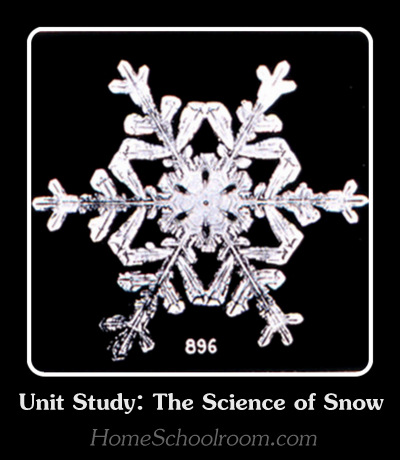
Our local public school was on vacation this week. I don’t usually take those weeks completely off, but they are perfect weeks to drop the regular curriculum and enjoy a fun unit study.
Though some of you may be fortunate enough that late February is the end of winter, in Maine spring is still weeks (months!) away. Great timing for a unit study on snow, focusing on the scientific aspects of snowflakes and crystals. After piquing their interest with the microscopic wonder of snowflakes I wanted to teach them about crystals and answer the question: Is it true that no two snowflakes are alike?
Wow! Snowflakes are miraculous!
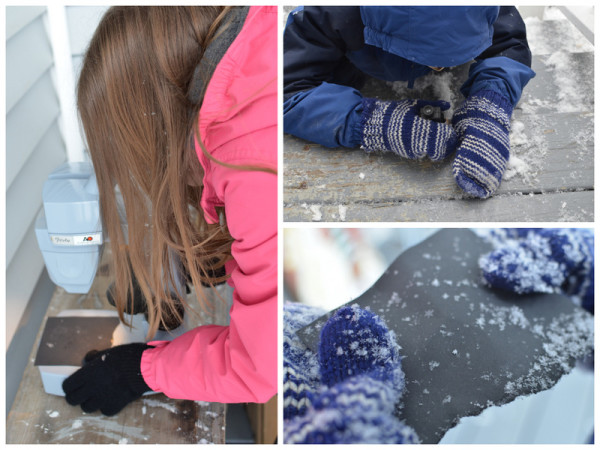
I laid the foundation for their interest a couple weeks ago when I saw large, beautiful flakes falling outside. Grabbing the piece of black paper I’d been keeping in my freezer for just such an occasion, we headed outside with various magnification tools: hand lenses, pocket microscopes, and a stereoscope. I highly recommend this activity whether you go on to study snowflakes or not.
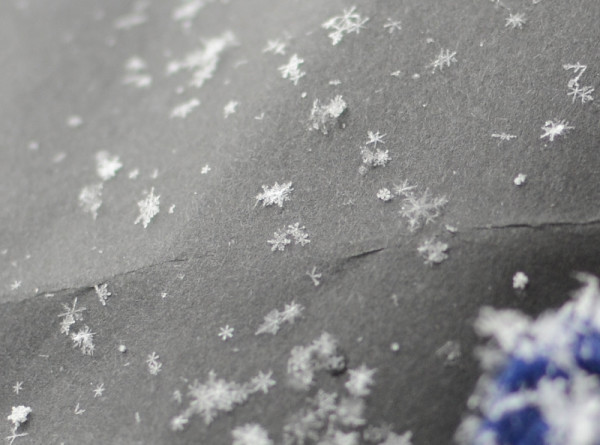
Then this week we kicked off the unit with the picture book Snowflake Bentley about Wilson Bentley, a man who lived in Vermont and spent his life photographing snowflakes to share their beauty with the world.
Homeschool Share offers a free lapbook to go along with this book and is where I found all the minibooks we used. We also perused the thousands of images in Wilson Bentley’s original book, Snow Crystals.
Learning about snowflakes and crystals
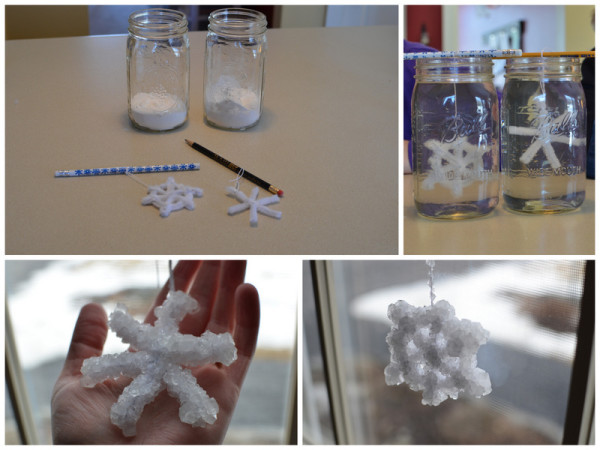
What better way to learn about crystals than to grow them? Making Borax snowflakes gave us the chance to watch crystal formation and drive home the main point: crystals arrange themselves into the patterns dictated by their molecules. While Borax crystals are simple cubes it is the same process that forms the intricate patterns found in each snowflake.
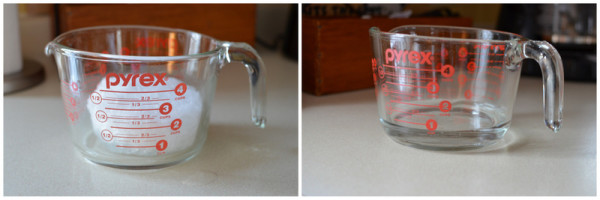
We brought in some snow and made guesses about how much water we would have when it melted. (All of our guesses were too high!) A nice printable from the Homeschool Share unit recorded the information. I used the physical demonstration from Living and Learning at Home to explain the scientific basis for it: we stood near each other with our arms out and realized we couldn’t stand very close to each other. With arms at our side we could pack ourselves in much more closely–just like the water molecules!
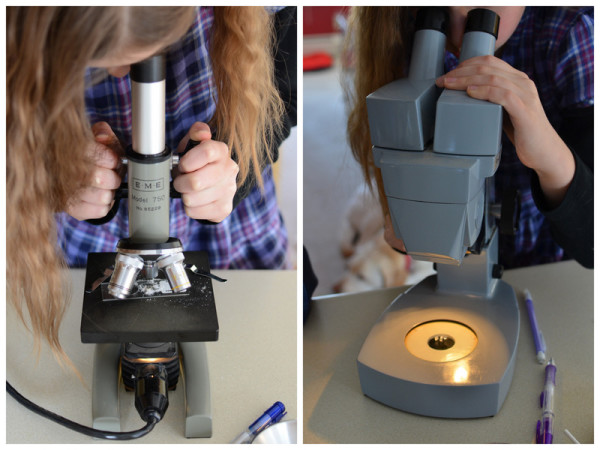
We brought out the microscopes to examine crystals of Borax, salt and sugar. My favorite part about using microscopes is how they increase our wonder at nature: when you see the tiny details you can’t help but be amazed!
Is it true that no two snowflakes are alike?
The book I used to cover the scientific information was The Snowflake: Winter’s Secret Beauty by Kenneth Libbrecht. This book was too advanced to be used as a read aloud, but was perfect for a picture walk. We looked at the images of modern snowflake photography and read the informative captions. This is great video clip about the author:
Once we learned about the factors affecting snow crystal formation, temperature and humidity, it was easy to understand the variety of patterns. As each individual snow crystal moves through different parts of the cloud due to wind and gravity the shapes on the branches tell the history of the conditions it went through. Since no two snowflakes follow exactly the same path to the ground, no two will be truly identical!
The Extras
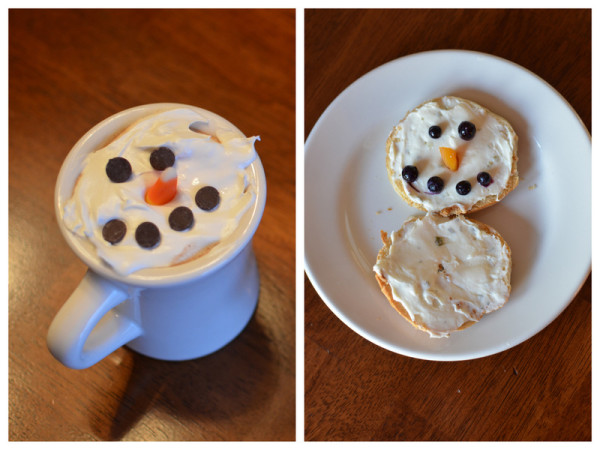
I usually can’t resist a little themed food when we’re studying a topic. Melted snowman cocoa and a snowman bagel fit the bill perfectly. The bagel face is made from blueberries and a piece of dried apricot. (Note: Be sure you have regular cream cheese for the bagel. Don’t be like me and only have chive and onion cream cheese.)
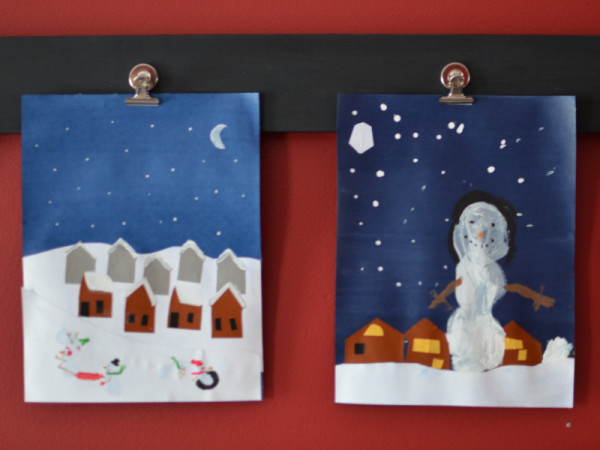
To finish the week we enjoyed a snowman art project from Deep Space Sparkle. She based it on the book Snowmen at Night, a delightful picture book we’ve enjoyed for years.
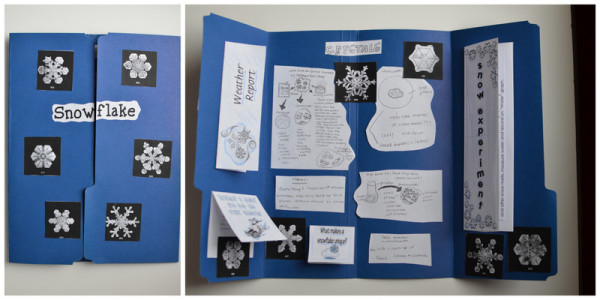
Inside my daughter’s lapbook you can see the minibooks from the Homeschool Share unit and drawings she made when we examined crystals under the microscope.
If you’re still in the throes of winter like me, take a peek at my Winter Activities Pinterest board. You’ll find ideas that are educational, crafty, and just plain fun!
I’m linking up with these great hostesses–join the fun and see what other homeschoolers are doing!
